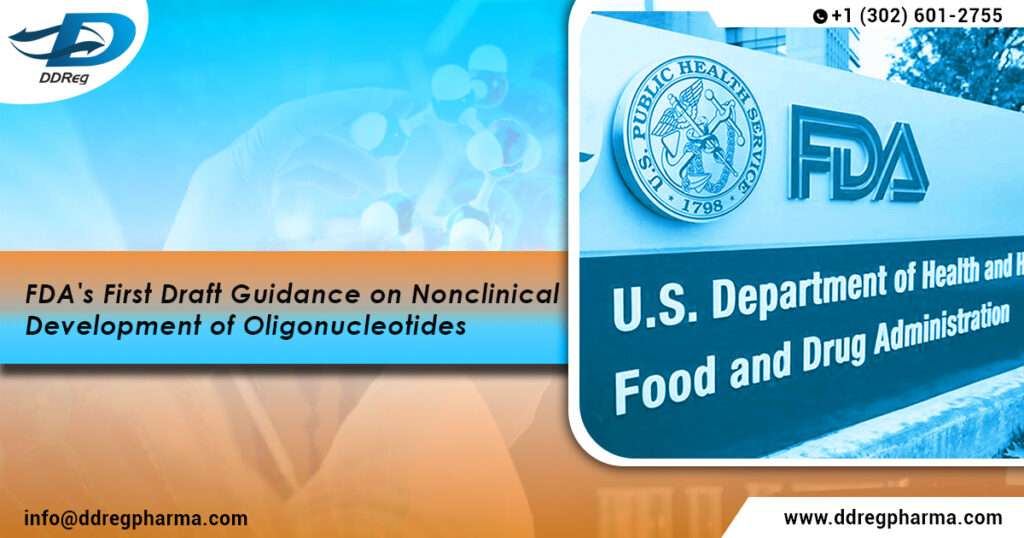The rapid evolution of biotechnology has positioned oligonucleotide-based therapeutics as one of the most promising therapeutic innovations in medicine today. From antisense oligonucleotides (ASOs) to small interfering RNAs (siRNAs) mRNA, and guide RNAs (gRNAs), these molecules are reshaping how we approach previously untreatable conditions. Recognizing the potential and complexity of this expanding area, and the need for a robust regulatory framework, the FDA has released its first draft guidance on the nonclinical development of oligonucleotide therapeutics.
The guidance emphasizes the necessity of safety assessments tailored to the distinct mechanisms of action of oligonucleotide therapeutics. For sponsors working on Investigational New Drug (IND) applications, the FDA offers crucial insights regarding on-target effects, off-target hybridization, and pharmacokinetics/pharmacodynamics (PK/PD).
Key recommendations include in Nonclinical Development of Oligonucleotides
- Toxicology Study Framework-
- Identifying pharmacologically active species for evaluating toxicological endpoints.
- Leveraging surrogates where human targets are absent in traditional test species.
- First-in-Human (FIH) Dose Selection-
- Starting doses based on the no-observed-adverse-effect level (NOAEL) in sensitive or relevant species.
- Adjustments for novel chemistries or unique dosing routes, such as intrathecal administration.
- Off-Target Assessment-
A key component is evaluating both on-target effects (exaggerated pharmacology) and off-target effects (which can be either hybridization-dependent or independent). For assessing off-target effects, the FDA recommends a three-tiered approach:
(i) | In Silico Analysis | Initial screening for potential hybridization to unintended targets. |
(ii) | In Vitro Validation | Testing identified targets in cellular assays. |
(iii) | In Vivo Monitoring | Studying the implications in animal models and clinical settings. |
These evaluations are grounded in computational and empirical data and are important for understanding the pharmacodynamics and toxicology of oligonucleotide candidates.
Class-Based Development
By leveraging existing data from well-characterized oligonucleotide platforms, sponsors can reduce redundancy and accelerate regulatory timelines. However, the utility of this approach hinges on data availability—either through public literature, sponsor ownership, or reference agreements.
Defining Safety Through Innovation
Oligonucleotides introduce unique challenges in safety assessment, particularly due to their ability to act on specific nucleic acid targets. The FDA emphasizes:
- Characterizing on-target effects through empirical studies or literature-based weight-of-evidence (WoE).
- Customizing designs based on tissue half-life, pharmacodynamics, and intended clinical use.
- Proactively addressing cytokine release and antidrug antibodies through integrated study designs.
Despite these advances, the guidance acknowledges areas needing further exploration. Novel chemical modifications (e.g., backbone and sugar alterations) require thorough investigation to understand metabolism and excretion pathways—a subject left somewhat open-ended in the current draft.
Platform-Based Approach
The FDA’s frequent mention of “class” and “surrogate” throughout the document signals a shift toward streamlined IND filings for oligonucleotides based on existing data. However, reliance on platform-based approaches requires that the data is:
- Publicly available in literature or recognized as general scientific knowledge.
- Proprietary to the sponsor.
- Accessible via a right of reference agreement.
Such flexibility underscores the FDA’s understanding of the resource-intensive nature of novel oligonucleotide development while maintaining rigorous safety standards.
Novel Modifications Demand New Data
Despite encouraging platform-based approaches, the FDA delineates clear boundaries for modifications to the chemical structure of oligonucleotides. New backbones, sugar modifications, or bases are treated as new chemical entities, warranting detailed metabolic and toxicological evaluations. This ensures that any changes do not introduce unforeseen risks, particularly concerning metabolism and off-target effects.
Implications for Industry Stakeholders
This draft guidance is like a regulatory checklist aligning preclinical research with FDA expectations. Pharmaceutical companies working in oligonucleotide-based therapies must consider the following:
- Early PK/PD Relationship Development: Establishing pharmacokinetic/pharmacodynamic relationships early ensures a seamless transition into clinical trials.
- Leveraging In Silico Methods: Incorporating robust computational models can expedite off-target assessments, saving time and resources.
- Transparency in Data Sharing: A platform approach necessitates a collaborative stance, whether through public data sharing or right of reference agreements.
The FDA’s draft for oligonucleotide-based therapeutics will serve as a crucial link between regulatory expectations and scientific progress. For pharmaceutical firms, it is important to align their development strategies with these recommendations to ensure a smooth path to IND approval and beyond.
Reach out to DDReg for expert guidance in aligning your nonclinical development with US FDA requirements. Contact us today for a consultation tailored to your needs. Read more from our experts on latest updates from FDA: FDA Launches REMS Public Dashboard to Enhance Transparency and Data Access

